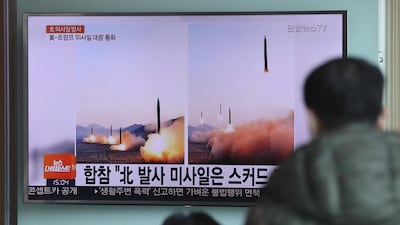North Korea’s rapid nuclear and missile advances and America’s rushed deployment of a ballistic missile defence system in South Korea have increased the risks of a war on the Korean Peninsula by accident or miscalculation.
Donald Trump may be battling the deep state at home but, in hastening the defence system’s deployment, his administration has presented a fait accompli to the next South Korean president. The new president will be elected in May after South Korea’s constitutional court recently upheld the impeachment of Park Geun-hye. It was Ms Park who agreed last July to the defence system.
The issue has become divisive in South Korean politics, and one presidential hopeful, Moon Jae-in, has said the system’s deployment unnecessarily escalates tensions on the peninsula. However, the Trump administration began its placement in early March.
Mr Trump gleefully challenged diplomatic orthodoxy during his own election campaign, including US foreign policy’s longstanding principles. Yet by implementing his predecessor’s defence system decision, Mr Trump has offered an example of how he is embracing key pillars of the previous administration’s foreign policy.
Two fundamental issues raised by the placement, however, cannot be obscured.
Firstly, the deployment has been necessitated by the abysmal failure of the US-led strategy to squeeze North Korea with ever-increasing sanctions while shunning any diplomatic engagement with it. The sanctions-only approach has only encouraged North Korea to advance its nuclear weapons and missile capabilities.
In the decade since the US froze all diplomatic contact with North Korea, that reclusive nation has gone from possessing rudimentary WMD capabilities to testing advanced systems that pose a regional threat.
For example, it tested a nuclear device last September whose yield, as recorded by outside seismic monitoring stations, was twice as powerful as the atomic bomb that the US dropped on Hiroshima in 1945. Since last year, Pyongyang has also tested solid-fueled missile systems.
And secondly, the defence system is no plausible answer to North Korea’s nuclearisation. Indeed, this is a case of the remedy being worse than the disease.
The deployment could counterproductively lead to North Korea aiming to defeat the defensive system by developing greater offensive capability.
In fact, China and Russia believe that its placement is part of a larger American plan to establish a fence of anti-missile systems around them.
Let’s be clear, the defence system cannot credibly protect South Korea from its neighbour’s short-range ballistic missiles.
Designed for high-altitude intercepts, it is geared to interdict intermediate-range ballistic missiles. Given South Korea’s relatively small land size, an attack by the North may not necessitate the use of medium-range missiles. Seoul is only 40 kilometres from the demilitarised zone.
North Korea has a virtual artillery choke-hold on Seoul that the defence system’s deployment cannot neutralise. This is why the US lacks a realistic option to militarily degrade the North’s nuclear and missile capabilities without provoking Pyongyang to unleash its artillery power against Seoul or triggering an all-out war. The absence of credible techno-military options against North Korea is also underscored by the failure of the US to undermine Pyongyang’s nuclear and missile programmes through coordinated cyber and electronic strikes in recent years.
In this light, the political symbolism is greater than the military utility. The defence system, in any case, has never been battle-tested.
Rather than enhance South Korea’s security, including by reassuring its citizens, its deployment threatens to make South Koreans more insecure.
Against this background, a new strategy is needed to stem the growing risk that a small mishap could escalate to a full-fledged war. Barack Obama employed sanctions with engagement to clinch a nuclear deal with Iran, yet throughout his eight-year tenure pursued a completely different approach towards North Korea – sanctions without engagement.
Given that the North Korean threat has reached a level defying solution through technological or military means, diplomacy must come into play to reduce tensions. For long, North Korea has sought direct talks with Washington. Mr Trump, during his campaign, said that he would be willing to meet with North Korean ruler Kim Jong-un over a burger.
If the defence system placement is not to prove counterproductive, Washington must shift to a sanctions-with-engagement policy towards Pyongyang, with the ultimate goal of clinching a WMD deal as part of a comprehensive peace treaty replacing the Korean War armistice. South Korea has an even bigger stake in engagement with the North in order to reduce the costs it will bear if reunification were to ever take place.
Brahma Chellaney is the author of nine books, including, most recently, Water, Peace, and War


